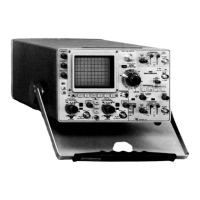Maintenance—485/R 485 Service
Cleaning the switch contacts should only be done using
isopropyl alcohol or a solution of 1% Joy detergent and
99% water. Do not use acetone, MEK, MIBK, benzol,
toluol, carbon tetrachloride, trichlor, trichlene, methyl
alcohol, methylene chloride, sulfuric acid, or Freon TC-TE-
TF-22-TA-12.
Air Filter. The air filter should be visually checked every
few weeks and cleaned or replaced if dirty. More frequent
inspections are required under severe operating conditions.
If the filter is to be replaced, order new air filters from your
local Tektronix Field Office or representative; order by
Tektronix Part No. 378 0036 01. The following procedure
is suggested for cleaning the filter.
1. Remove the filter by pulling it out of the retaining
frame on the rear panel. Be careful not to drop any of the
accumulated dirt into the instrument.
2. Flush the loose dirt from the filter with a stream of
hot water.
3. Place the filter in a solution of mild detergent and
hot water and let it soak for several minutes.
4. Squeeze the filter to wash out any dirt which
remains.
5. Rinse the filter in clean water and allow it to dry.
6. Coat the dry filter with an air-filter adhesive (avail
able from air conditioner suppliers or order Tektronix Part
No. 006-0580-00).
7. Let the adhesive dry thoroughly.
8. Re-install the filter in the retaining frame.
Exterior. Loose dust accumulated on the outside of the
485 can be removed with a soft cloth or small brush. The
brush is particularly useful for dislodging dirt on and
around the front-panel controls. Dirt which remains can be
removed with a soft cloth dampened in a mild detergent
and water solution. Abrasive cleaners should not be used.
CRT. Clean the plastic light filter, and the CRT face
with a soft, lint-free cloth dampened with denatured
alcohol.
The CRT mesh filter (furnished with EMI Option 4
only) can be cleaned in the following manner:
1. Hold the mesh filter in a vertical position and brush
lightly with a soft No. 7 water-color brush to remove light
coatings of dust or lint.
2. Greasy residues or dried-on dirt can be removed with
a solution of warm water and a neutral-pH liquid detergent.
Use the brush to lightly scrub the filter.
3. Rinse the filter thoroughly in clean water and allow
to air dry.
4. If any lint or dirt remains, use clean low-pressure air
to remove it. Do not use tweezers or other hard cleaning
tools on the filter, as the special finish may be damaged.
5. When not in use, store the mesh filter in a lint-free,
dust-proof container such as a plastic bag.
Interior. Dust in the interior of the instrument should be
removed occasionally due to its electrical conductivity
under high-humidity conditions. The best way to clean the
interior is to blow off the accumulated dust with dry,
low-pressure air. Remove any dirt which remains with a soft
paint brush or a cloth dampened with a mild detergent and
water solution. A cotton-tipped applicator is useful for
cleaning in narrow spaces or for cleaning ceramic terminal
strips and circuit boards.
The high-voltage circuits, particularly parts located in
the high-voltage compartment and the area surrounding the
post-deflection anode leads, should receive special atten
tion. Excessive dirt in these areas may cause high-voltage
arcing and result in improper instrument operation.
Lubrication
The potentiometers, cam switches and pushbutton
switches used in this instrument are factory lubricated and
should not require further lubrication.
The fan-motor bearings are sealed and do not require
lubrication.
4-2
REV. C. SEPT. 1974

